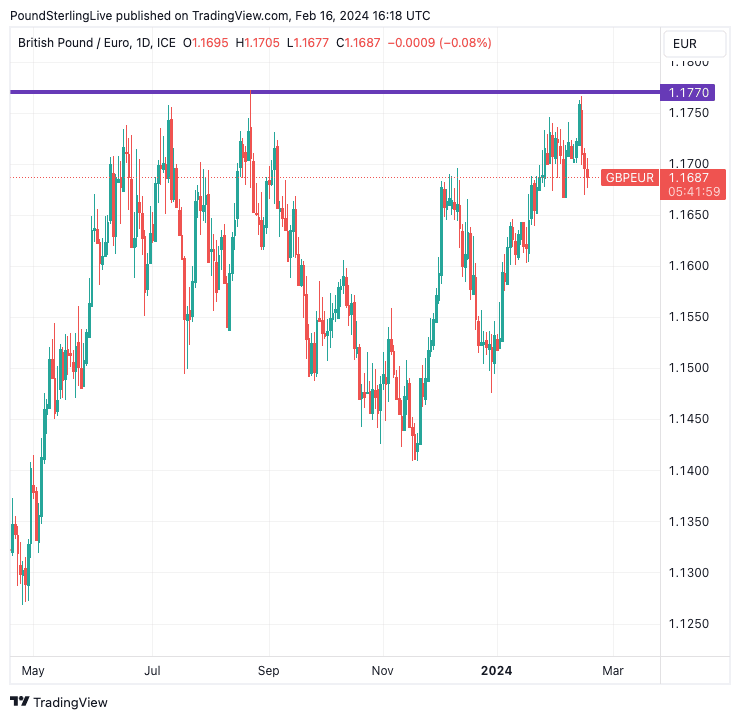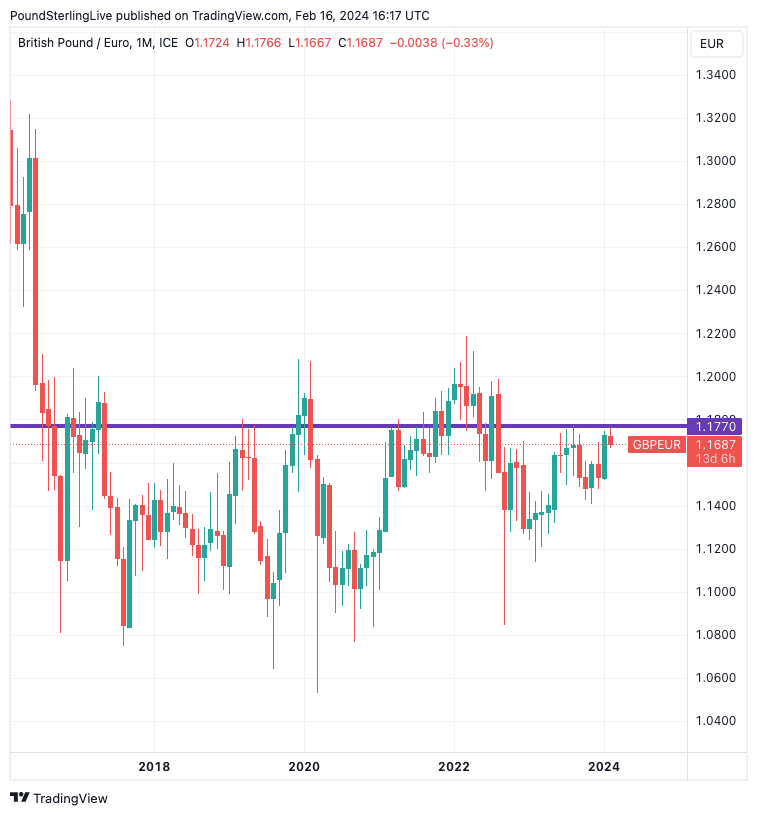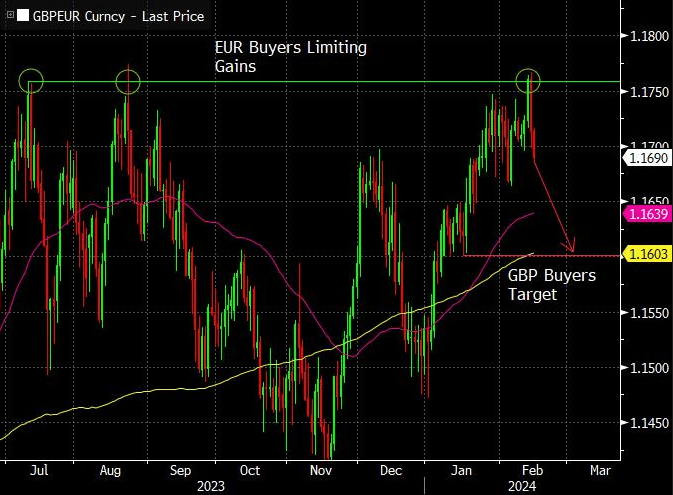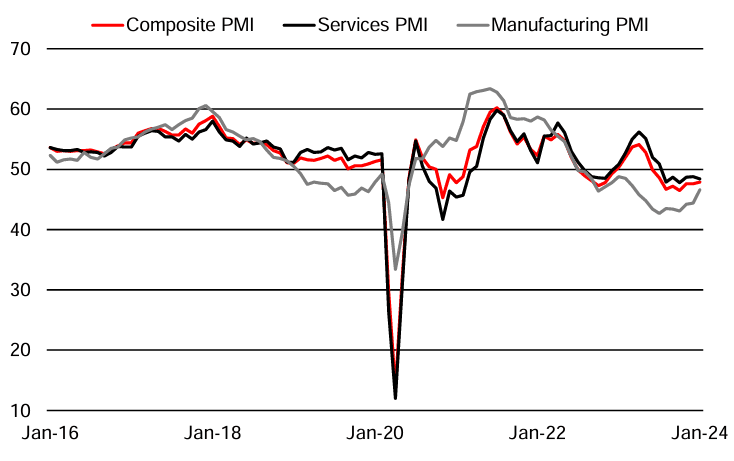Pound to Euro Week Ahead Forecast: Back to Mid-January Levels?
- Written by: Gary Howes
-
- GBP sellers back in control
- 1.1770 resistance won't yield
- Further pullback is possible
- EU and UK PMIs form the week's highligh

Image © Adobe Images
The Pound to Euro exchange rate stormed to fresh 25-week highs last week but ultimately (and predictably) hit a wall of selling interest; the coming days suggest scope for a further retreat from recent highs.
The issue facing Pound-Euro is that strong technical resistance line that resides in the 1.1770 area (note that this forms the round number of 0.85 when we reverse the analysis into Euro-Pound terms).
The daily chart shows the high likelihood of failure here:
It is interesting to note that this line is making itself known as the upper-bound level of the post-Brexit reset in the exchange rate, as per the weekly chart which allows us to zoom out a bit:
Live GBP/EUR Money Transfer Exchange Rate Checker | ||
Live Market Rate: | get quick quote | |
Corpay: | ||
Banks: Median Low | ||
Banks: Median High | ||
These data are based on the spread surveyed in a recent survey conducted for Pound Sterling Live by The Money Cloud. | ||
In short, gains in the pair above 1.17 are hard to come by and we warned readers with euro requirements that they should act on forays above 1.1725.
Bill McNamara, analyst at The Technical Trader, says sellers have regained control of the Pound-Euro, even last Friday's blowout UK retail sales were unable to entice buyers to take control.
"So what’s next? The recent intermediate low, at 1.1668, might well provide support; failing that, a reversion to 1.163 or so looks likely," says Mcnamara.
"We look for a move to the mid-January levels where the pair should garner support once again," says Thanim Islam, Head of FX Analysis at Equals Money.
Image courtesy of Equals Money.
"In the short term we feel some of the optimism on GBP will be unwound, as markets will look to take profits on GBP gains so far this year," adds Islam.
It's worth pointing out that GBP/EUR is moving in relatively tight ranges as implied volatility has dropped to its lowest level since 2007; this tells us that the coming week will likely see any big moves in either direction faded by the market.
The highlight of the UK data calendar is Thursday's release of PMI survey data for February, due 09:30 GMT, where confirmation of a strengthening in economic activity is anticipated to have extended from January's solid figures.
Track GBP with your own custom rate alerts. Set Up Here
Markets look for the manufacturing PMI to have recovered slightly to 47.1, services to have edged up to 54.4 and the composite to have eased to 52.7.
The lesson of the immediate past is that the British Pound is now proving more reactive to negative data surprises, which leads us to expect that any gains that follow positive surprises in the data will be limited.
Instead, the biggest moves are likely to follow downside misses in the data, which suggests risks are pointed lower heading into Thursday.
A case in point is the significant selloff in Sterling following December's retail sales miss, which contrasts with the almost indifferent market reaction to the arguably larger upside surprise that came a month later with the release of January's figures.
Live GBP/EUR Money Transfer Exchange Rate Checker | ||
Live Market Rate: | get quick quote | |
Corpay: | ||
Banks: Median Low | ||
Banks: Median High | ||
These data are based on the spread surveyed in a recent survey conducted for Pound Sterling Live by The Money Cloud. | ||
There is some decent data to chew over from the Eurozone this week, with the focus falling on Thursday's preliminary PMI survey for February (09:00 GMT).
The market looks for the Eurozone services PMI to print at 48.7, manufacturing at 47 and the composite at 48.3; recall anything below 50 signals contraction. The rule of thumb is the Euro can come under pressure if the data undershoots.
"Advance PMIs next Thursday could be crucial for rates and FX and any renewed weakness in advance PMIs in Europe could see the dollar advance more notably," says Derek Halpenny, Head of Research for Global Markets EMEA at MUFG Bank Ltd.
Image courtesy of UniCredit.
But with so much economic gloom priced into the euro, we reckon it would take a whopping undershoot to really get the currency falling. Instead, risks are to the upside with a greater reaction function to any better-than-expected prints, which is the opposite of how we see GBP risks.
In a weekly assessment, UBS says flash PMIs may show signs of a potential rebound in activity, "which would be positive for the euro... economic data surprises have been a bit stronger in recent weeks, which typically helps the common currency".
Also on tap is the release of German GDP numbers on Friday where a -0.2% quarter-on-quarter print is expected for the fourth quarter, which would confirm a technical recession owing to Q3's -0.02% print.
Also due Friday is the more timely IFO survey of economic conditions and expectations, which should offer markets clues as to whether the worst has passed for Europe's biggest economy. (Current assessment expected at 87, expectations at 83.80).
"We expect the Ifo Business Climate Index to rise to about 86.5 in February after two consecutive declines. Such an increase is likely to have been driven by both the business expectations and the current situation components," says a note from UniCredit Bank.







